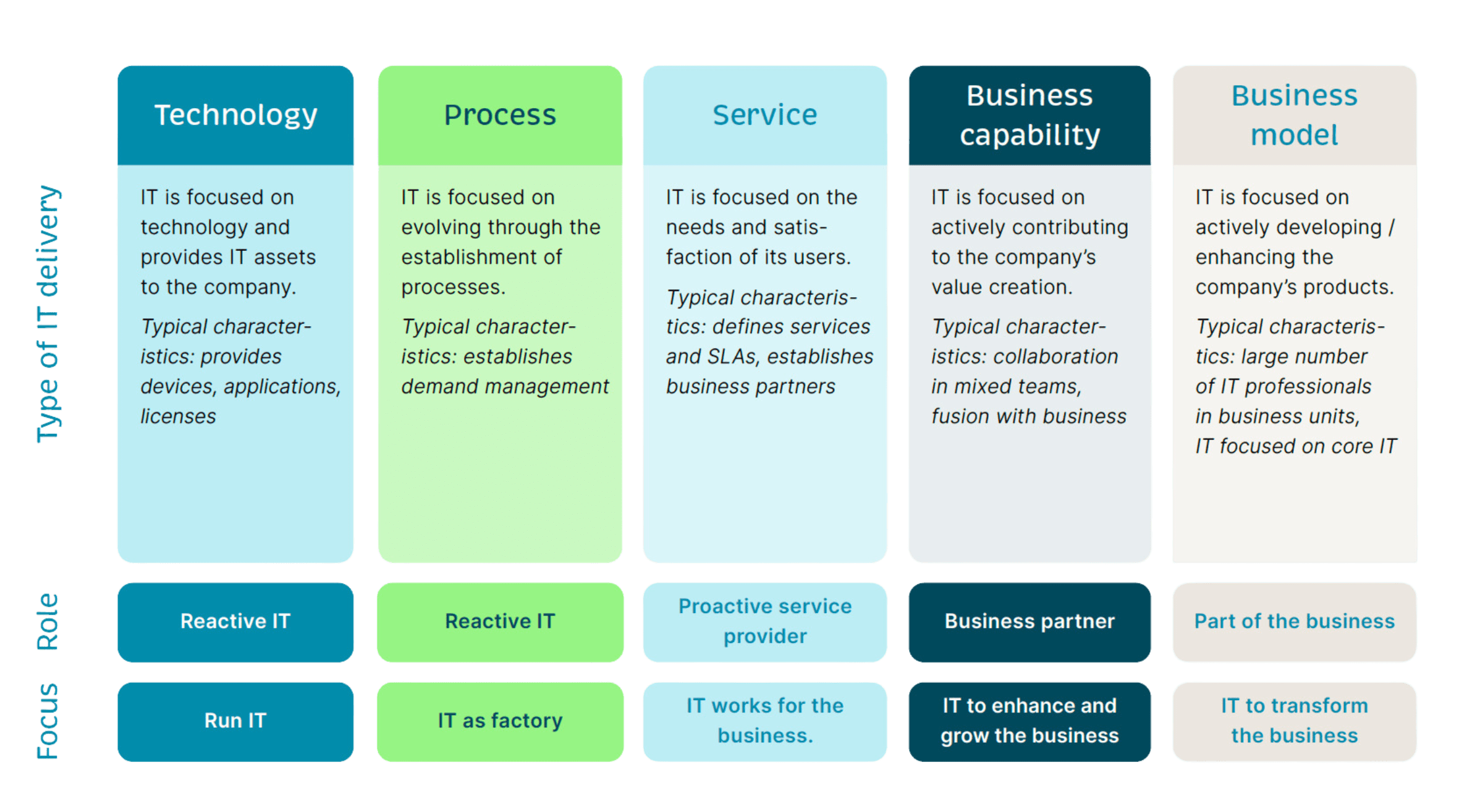Are IT departments today like a battered ship at risk of sinking in the storm of the digital transformation? It’s an apt comparison, since the rapid development of artificial intelligence and the new solutions it is unlocking has further accelerated innovation cycles, along with the transition to data-driven organizations. Beyond that, citizen development is growing more and more important: Teams no longer work together merely along functional lines, but instead on an interdisciplinary basis so they can focus more on products. This situation requires a strategically considered plan for the transformation of the IT department to keep the ship afloat in the long term.
So how can IT departments cope with – and, even better, actively manage – constant change so they don’t get blown off course amid the storm of innovation and can instead harness the resulting advantages in structural terms?
Staying afloat in the rough weather of the digital transformation
Ongoing technological, procedural, and organizational volatility is increasingly taking up companies’ resources to the point that they can no longer respond to new business requirements. When this happens, the IT department frequently experiences bottlenecks in efficiently introducing and managing new technologies. The result? Projects are delayed, technological implementation does not take place on time, and the company’s innovative drive and competitiveness take a hit.
In the maturity level model shown below, the basic concept developed by Campana & Schott to assess an organization’s developmental status in the area of information technology, many companies currently fall within the “Process” and “Service” categories.

From process and service IT to business capability IT
This maturity level model makes it clear that companies need to make further gains in innovative drive and agility if they are to meet volatile market requirements. The IT organization is a key factor in this. It has to evolve into a business enabler, which will allow companies to meet the challenges of the future strategically. What is important is not merely accepting the change, but recognizing it as an opportunity and charting the course for the future. After all, change is no longer just a passing phase, but a lasting reality.
Want to learn more about the maturity level model and take your business to the next level? Download our white paper now!
The IT organization can reach the next maturity level, business capability, by strengthening and building on IT management skills and capabilities. There are three key aspects here, which the next section explores in more detail.
Three key aspects of change
IT departments need to incorporate three key aspects into their IT management capabilities so they will no longer be like a battered ship at risk of sinking in the storm of the digital transformation.

Let’s take a closer look at each of these factors:
Factor 1 – architecture. Enterprise architecture management (EAM) and the need for modularity.
IT departments face the herculean task of continuously adjusting their architecture to unleash the full potential of the latest technologies. A rigid IT architecture that cannot accommodate change runs the risk of missing out on crucial innovation opportunities.
A modular IT architecture allows an organization to keep up with rapid changes in technologies and seamlessly incorporate those changes. The flexibility this provides allows companies to manage change efficiently without losing sight of the big picture.
Business requirements are the driving force behind the design of the IT architecture. Every adjustment in the IT architecture should be geared toward the specific business field and its individual needs and requirements. Close consultation and transparency between the business and IT architecture are crucial in achieving this effectively. An in-depth understanding of interdependencies and a clear focus on business processes are essential to reducing the complexity of the architecture.
Factor 2 – organization. A culture of collaboration and shared responsibility.
But change isn’t only about using new technologies. It also requires an in-depth organizational course correction. The days when IT and business existed in their own separate worlds are over. Modern organizations need to blur these lines and cultivate a culture of shared responsibility and integrated teams. This new era of collaboration requires fluid lines between business and IT, and both sides need to learn to speak the same language and pursue shared objectives.
Traditional silo structures in a company’s organization and isolated work are a thing of the past and need to be replaced. The focus now is on mixed teams that share responsibility. This new form of collaboration requires a change in the corporate culture. The management needs to do more than just supporting this transformation; they need to actively forge ahead with it.
As the business and IT sides work together more closely, the need for knowledge also increases. Specific formats such as communities can allow for horizontal exchanges of ideas and viewpoints while sharing technological and process knowledge.
The necessary cultural change that precedes this collaboration can be brought about through pilot projects, for example, with the IT and business sides working together to define a culture for the project, testing that culture within the project, and subsequently bringing it out into the company as a whole. Projects like these also help to cultivate a new culture of failure and to empower employees.
Factor 3 – processes & governance. Agility for flexibility and speed of action.
At the same time, companies also need to adjust their business processes and governance structures in order to keep pace with the rapid changes taking place on the market. Speed and flexibility are becoming crucial competitive factors. The ability to manage technological complexity effectively and utilize governance instruments with skill is becoming increasingly important.
Rigid processes need to be broken down and replaced by optimized, agile digital processes. Flexible and iterative planning is taking the place of long-term annual plans in some areas. This means companies can respond to changes quickly and efficiently.
At the same time, the governance structure needs to be adjusted to the new freedoms brought by the newly agile processes and the fact that individual IT tasks are shifted to the business side. Effective governance ensures that even with greater flexibility and speed of action, the necessary control is still in place. This calls for thoughtfully considered guidelines, but that is not all. It also requires managers who fully embrace this form of governance. The balance this creates between freedom and control is crucial to the long-term success of the IT transformation.
Takeaway: the path forward
IT departments and the ability to manage IT strategically are now more important than ever in permitting companies to survive and thrive in our volatile world. Change should be embraced as an opportunity to set the course for what lies ahead. Concretely, this means that companies will have to take their IT organization to a higher level of maturity and balance the three key factors: architecture, organization, and processes & governance. It is not enough to rely on individual measures. Successful execution is crucial when it comes to responding to the speed of innovation in new technologies and trends. A proactive approach is needed here, so the ship is equipped to safely navigate all the changes to come and create the IT department of the future.
Take the crucial first step now: Our quick IT check
So you want to take action now to build an IT organization that can stand up to future challenges. But where do you start? Our quick IT check can help you figure it out.
You will answer targeted questions from our experts during a four-hour intensive workshop. This lets us get a snapshot of where your IT organization stands today, along with the management competencies involved. What you get from us is a clear recommendation on your strengths and the areas where you have room to improve, so you know where you can take concrete action. This way, you can set out a detailed roadmap and further develop your IT management capabilities strategically, so you are ready for the challenges of a volatile world.



